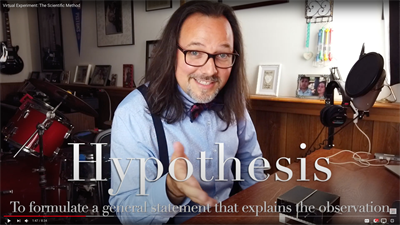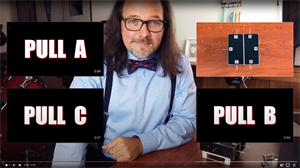
Professor Jesse Mason is quietly making a difference in how science is taught.
Literally.
Mason, who is teaching Physics 123 this semester, just published the world’s first YouTube virtual science experiment.
Using end-screen video links that allow viewers to choose which actions to perform next on a mysterious little black box, Mason designed a fun and interactive educational experience for YouTube viewers that cements the conceptual foundation of science itself: the scientific method.
“This is a beautifully simple experiment I’ve done for years with my students,” Mason said. “The students pull these tiny rods out of a sealed cardstock box listening for sounds that clue them in on the contents of the box. The students love it; they learn the scientific method, and now with YouTube as the laboratory, the experiment can be done from anywhere.”
 Indeed, Mason’s virtual science experiment has already been performed over 1,000 times by students from around the world (including his PHYS 123 students).
Indeed, Mason’s virtual science experiment has already been performed over 1,000 times by students from around the world (including his PHYS 123 students).
As a veteran YouTube content creator with millions of views, Mason is accustomed to generating popular educational videos. This summer Mason strayed from his typical problem-solving videos for students to create a unique series of physics demonstration videos aimed at remote physics teachers.
“I call these videos ‘demo blanks’ because there’s no explanation offered in the video, just a well-produced HD recording of the demonstration,” Mason said. “Unlike the rest of the demo content on YouTube, my demo blanks can be used for both teaching and assessment: teachers can explain the physics of the demo to the student or have the student explain it to them, perhaps for credit.
“With the sudden avalanche of remote learning, the demo blanks are becoming popular with physics teachers hungry for a more versatile collection of recorded physics demonstrations for their remote courses.”
You can view a demo blank example here.
Earlier this year, Mason piloted Saganworks, 3D environmental software now used by thousands, to create the world’s first virtual physics classroom for the latter half of the Winter 2020 semester when classes pivoted from in-person teaching to distance learning.
In brief, Saganworks allows the user to create a SAGAN, which is a 3D virtual space for storing information. SAGAN is an acronym for Spatially Accessible Gallery of Archived kNowledge. The name also pays tribute American astronomer and physicist Carl Sagan.
Of course, SAGANS are part of this semester, too, for Mason’s physics students.
“In addition to providing a shared online repository for all our handouts, coursework and assigned videos, the class will be using Saganworks to construct educational exhibits for their final project,” Mason said.
Go learn more about Mason’s initial work with this groundbreaking software.